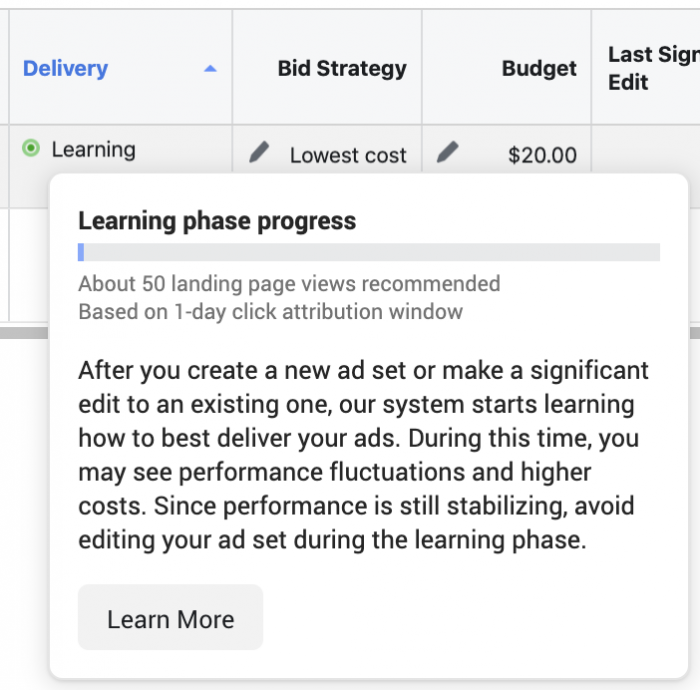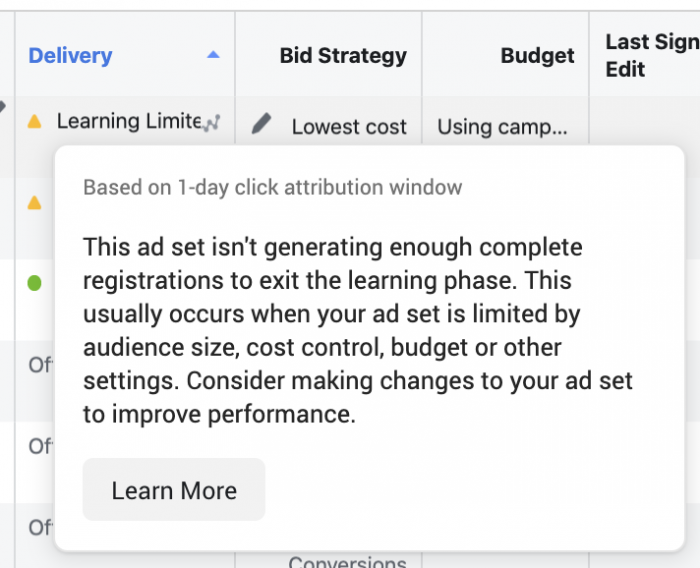You recently started a Facebook ads campaign. Your ads aren’t performing as well as you had hoped. Your impulse will be to make a change or stop the ads entirely. Instead, you may want to wait.
Why? The Learning Phase. You need to get through it first. Until then, your ads won’t perform to their full capability.
Let’s take a closer look at the Learning Phase and how it impacts your advertising…
What is the Learning Phase?
When you first start (or make a significant edit to) an ad set, Facebook has to learn how to best distribute your ads. As more people see your ads, Facebook learns about what types of people engage with, ignore, or react negatively to them.
This is the Learning Phase. When understood, it can lead to optimal performance of your Facebook ads. Otherwise, it may only create frustration.
Facebook typically requires 50 desired actions (the action you are optimizing for) within an ad set during a seven day period to exit the Learning Phase. Sometimes it happens faster.
If your ad set is within the Learning Phase, it will say “Learning” under the Delivery column while viewing your ad set.

If you are optimizing for conversions, for example, your ad set will need to generate around 50 conversions during the initial seven-day period to exit the Learning Phase. Understand that this applies to each individual ad set within a campaign. If you have multiple ad sets, the number isn’t aggregated.
While Facebook is in the process of “learning,” your results may be suboptimal. Your Cost Per Action won’t be great. Unless it’s a situation where your results are so poor that you don’t expect to exit the Learning Phase, let it ride.
Optimization and the Learning Phase
How quickly will you reach that 50 action threshold and exit the Learning Phase? A big factor is the action you optimize for.
Some actions are very light and easy to get. You may quickly exit the Learning Phase when optimizing for any of the following:
- Impressions
- Reach
- Daily Unique Reach
- Post Engagement
- Video Views
- Link Clicks
- Landing Page Views
But volume will be more difficult to come by when you are optimizing for deeper actions like conversions, app installs, and leads. It’s important to understand this relationship when starting your campaign.
The fewer actions you are able to generate in a day from a given ad set, the longer it will take to exit the Learning Phase. The longer it takes, the more likely you may not exit the Learning Phase at all.
If you are unable to generate the volume of actions that are required to exit the Learning Phase within your budget, and you are unable to combine ad sets to generate more volume, consider optimizing for a different action.
For example, maybe you are promoting a $100 product but you are only given a $10 per day budget to work with. You will never generate the volume you need to exit the Learning Phase.
Consider optimizing for landing page views, clicks, or post engagement instead. Or, you may even target your hottest possible audience and optimize for Reach.
Budget and the Learning Phase
Any action that you take as an advertiser that limits volume of actions for an ad set is going to affect the Learning Phase.
If your budget is $10,000 per day for a given ad set, it really doesn’t matter what action you optimize for. More than likely, you’re going to exit the Learning Phase — and quickly.
But, a $10 per day budget could be problematic. With such a budget, you are spending $70 during a 7-day period. To exit the Learning Phase, you’d be required to generate, at minimum, one action per $1.40 spent.
While you’re likely to generate a desired action at the $1.40 rate or better when optimizing for most, if not all, of the light actions described above, you are much less likely to do so when optimizing for a heavier action like a conversion.
Before starting an ad set, do some basic math. How much do you expect a desired action to cost? Multiply that number by at least 75 to determine a minimum weekly budget.
Audience Size and the Learning Phase
Maybe your budget is high enough, but a small audience may prevent you from even reaching that budget. As a result, you’re less likely to exit the Learning Phase.
This can happen when targeting small countries, especially if you then layer in small interests or smaller warm audiences, like Custom Audiences.
If a small audience size is preventing you from exiting the Learning Phase, consider including more countries or expanding your interests. If using Custom Audiences, you may extend the duration (180-day maximum for Website Custom Audiences and 365 days for engagement) or adjust the action to generate more volume.
CBO and the Learning Phase
It’s great when you can control the budget at the ad set level. But, what if you’re using Campaign Budget Optimization? It gets tricky.
With Campaign Budget Optimization, you set your budget at the campaign level. Facebook then distributes budget optimally between the ad sets. How Facebook distributes that budget will depend upon the size and performance of the audience within each ad set.
While it’s not an exact science, you can do some basic math to determine whether your campaign budget is enough to sustain each ad set and get you through the Learning Phase. Let’s assume a $100 daily budget and ad sets with the following audience sizes:
- Ad Set #1: 5,000,000
- Ad Set #2: 3,500,000
- Ad Set #3: 1,000,000
- Ad Set #4: 500,000
The total audience size, assuming no overlap, is 10,000,000 (how convenient!). When applying the same ratios to your daily budget, you’d theoretically spend the following per day:
- Ad Set #1: $50
- Ad Set #2: $35
- Ad Set #3: $10
- Ad Set #4: $5
Is $5 per day ($35 per week) enough to get the 50 desired actions you need to exit the learning phase? If not, consider combining a couple of the ad sets.
Learning Limited
If your ad set fails to exit the Learning Phase, you will see “Learning Limited” within the Delivery column.

This happened to me when running a campaign under the following conditions:
- Optimized for Complete Registrations
- Used Campaign Budget Optimization
- Spend of $50 per day
- Four different ad sets, by country grouping
There are a few reasons why you might split out ad sets by country grouping, but one was that it allowed me to be more specific about the time of a webinar I was promoting. Instead of using the EST time zone for all of my ads, I could use AEDT or GMT for an audience where that would be more relevant.
Of course, that is great only if I can get the proper volume that I need to exit the Learning Phase. I couldn’t, so I stopped the affected ad sets and combined audiences.
Watch the Video
Your Turn
Facebook optimization is smart, but you have to provide the proper environment to allow it to do its job. I’m finding that my results often improve after exiting the Learning Phase.
Anything you’d add regarding how you manage the Learning Phase?
Let me know in the comments below!






